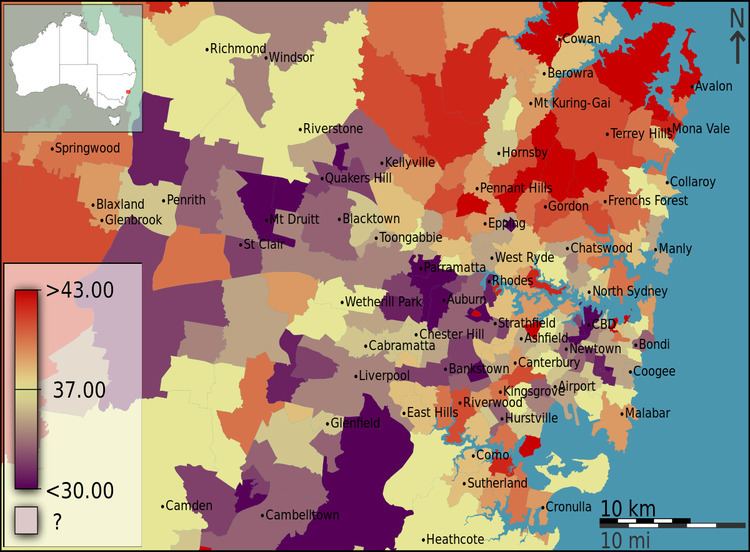 | ||
Sydney is Australia's most populous city, and is also the most populous city in Oceania. In the 2011 census 4,627,345 persons declared themselves as residents of the Sydney Statistical Division–about one-fifth (19.38%) of Australia's total population. If contiguous urban areas are considered, Sydney's population was 3,641,421 persons. Sydney is also the most densely populated city in Australia.
Contents
The median age of Sydney residents was 35 years, and households comprised an average of 2.7 members.
The officially estimated population for the Sydney Statistical Division at 30 June 2010 was 4,575,532.
History
European settlement in Sydney began in 1788, and in 1800 Sydney had around 3,000 inhabitants. It took time for the city's population to grow–in 1851 its population was only 39,000, compared with 77,000 in Melbourne. The subsequent gold rushes in Victoria caused the population of Melbourne to increase rapidly, while the lesser gold rushes in New South Wales had a less profound effect on the population of Sydney.
Sydney overtook Melbourne as Australia's most populous city in the early twentieth century, and reached the million inhabitants milestone around 1925. The opening of the Sydney Harbour Bridge helped pave the way for further urban development north of Sydney Harbour. Post-war immigration and a baby boom helped the population reach two million by 1962. Sydney remained Australia's most populous city throughout the 20th Century, and is projected to retain this position for much of the 21st Century.
Ethnic groups
The principal ancestries of Greater Sydney's residents (as surveyed in 2011) are:
Census respondents could nominate up to two ancestries they identified themselves as belonging to.
The principal countries of birth of Greater Sydney's residents (as surveyed in 2011) are:
Aborigines were about 1.1% of all Sydney residents.
Sydney has a disproportionately large concentration of many of Australia's migrant communities. The Lebanese, Fijian, Korean and Nepalese communities have been called "large population groups". Well over half of Australia's 25,000-strong Nepalese community, for example, is concentrated in Sydney. Seven out of every ten Lebanese migrants in Australia live in Sydney. The Ghanaian community has been noted as being disproportionately visible in Sydney, with the number of Ghanaian churches being unusually large considering the relatively small number of Ghanaians in Australia.
The most common languages spoken at home are English (the sole language of 60.8% of the population), Arabic (spoken by 4.4%), Cantonese (3.4%), Mandarin (2.6%), Greek (2.2%) and Vietnamese (2.0%).
Some suburbs are associated with particular ethnic groups. The adjacent image shows concentrations of persons born in different regions of the world residing in particular parts of Sydney.
Religion
At the 2006 Census, the most common responses for religion were Catholic (29.2%), Anglican (16.5%), Eastern Orthodox (4.8%) and Islam (4.4%). 14.1% declared no religious affiliation. 10.4% left the question blank, 3.7% were Buddhists, 1.7% were Hindu, 0.9% were Jewish.
The 2011 Census most common responses were Catholic, (28.3%), Anglican (14.7%), Islam (5.3%) and Eastern Orthodox (4.6%). 17.5% declared no religion.
